Susceptibility of HepG2 Cells to Silver Nanoparticles in Combination with other Metal/Metal Oxide Nanoparticles
Abstract
1. Introduction
2. Materials and Methods
2.1. Nanoparticle Preparation and Characterization
2.2. Cell Culture
2.3. Flow Cytometry Evaluation of Cellular Binding/Uptake of Nanoparticles by Cells
2.4. Cytotoxicity Evaluation
2.5. Measurements of Reactive Oxygen Species Formation
2.6. Alkaline Comet Assay
2.7. The Concept of “Expected Value”
2.8. Statistical Analysis
3. Results
3.1. Nanoparticles Characterization
3.2. Flow Cytometry Evaluation of Cellular Binding/Uptake of NPs
3.3. Cytotoxicity
3.4. ROS Induction
3.5. Single-Cell Gel Electrophoresis
4. Discussion
5. Conclusions
Supplementary Materials
Author Contributions
Funding
Conflicts of Interest
References
- Horikoshi, S.; Serpone, N. Introduction to nanoparticles. In Microwaves in Nanoparticle Synthesis; John Wiley & Sons, Ltd: Hoboken, NJ, USA, 2013; pp. 1–24. ISBN 978-3-527-64812-2. [Google Scholar]
- Salata, O.V. Applications of nanoparticles in biology and medicine. J. Nanobiotechnology 2004, 2, 3. [Google Scholar] [CrossRef] [PubMed]
- Ahamed, M.; Khan, M.A.M.; Akhtar, M.J.; Alhadlaq, H.A.; Alshamsan, A. Ag-doping regulates the cytotoxicity of TiO2 nanoparticles via oxidative stress in human cancer cells. Sci. Rep. 2017, 7, 17662. [Google Scholar] [CrossRef] [PubMed]
- Filipak Neto, F.; Cardoso da Silva, L.; Liebel, S.; Voigt, C.L.; Oliveira Ribeiro, C.A. de Responses of human hepatoma HepG2 cells to silver nanoparticles and polycyclic aromatic hydrocarbons. Toxicol. Mech. Methods 2018, 28, 69–78. [Google Scholar] [CrossRef] [PubMed]
- Miranda, R.R.; Bezerra, A.G.; Oliveira Ribeiro, C.A.; Randi, M.A.F.; Voigt, C.L.; Skytte, L.; Rasmussen, K.L.; Kjeldsen, F.; Filipak Neto, F. Toxicological interactions of silver nanoparticles and non-essential metals in human hepatocarcinoma cell line. Toxicol. Vitro 2017, 40, 134–143. [Google Scholar] [CrossRef]
- Zuberek, M.; Wojciechowska, D.; Krzyzanowski, D.; Meczynska-Wielgosz, S.; Kruszewski, M.; Grzelak, A. Glucose availability determines silver nanoparticles toxicity in HepG2. J. Nanobiotechnology 2015, 13, 72. [Google Scholar] [CrossRef]
- Fraga, S.; Faria, H.; Soares, M.E.; Duarte, J.A.; Soares, L.; Pereira, E.; Costa-Pereira, C.; Teixeira, J.P.; de Lourdes Bastos, M.; Carmo, H. Influence of the surface coating on the cytotoxicity, genotoxicity and uptake of gold nanoparticles in human HepG2 cells. J. Appl. Toxicol. JAT 2013, 33, 1111–1119. [Google Scholar] [CrossRef]
- Peng, L.; He, M.; Chen, B.; Wu, Q.; Zhang, Z.; Pang, D.; Zhu, Y.; Hu, B. Cellular uptake, elimination and toxicity of CdSe/ZnS quantum dots in HepG2 cells. Biomaterials 2013, 34, 9545–9558. [Google Scholar] [CrossRef]
- Li, Y.; Sun, L.; Jin, M.; Du, Z.; Liu, X.; Guo, C.; Li, Y.; Huang, P.; Sun, Z. Size-dependent cytotoxicity of amorphous silica nanoparticles in human hepatoma HepG2 cells. Toxicol. Vitro 2011, 25, 1343–1352. [Google Scholar] [CrossRef]
- Lu, X.; Qian, J.; Zhou, H.; Gan, Q.; Tang, W.; Lu, J.; Yuan, Y.; Liu, C. In vitro cytotoxicity and induction of apoptosis by silica nanoparticles in human HepG2 hepatoma cells. Int. J. Nanomed. 2011, 6, 1889–1901. [Google Scholar] [CrossRef]
- Kitchin, K.T.; Stirdivant, S.; Robinette, B.L.; Castellon, B.T.; Liang, X. Metabolomic effects of CeO2, SiO2 and CuO metal oxide nanomaterials on HepG2 cells. Part. Fibre Toxicol. 2017, 14, 50. [Google Scholar] [CrossRef]
- Landgraf, L.; Nordmeyer, D.; Schmiel, P.; Gao, Q.; Ritz, S.; Gebauer, J.S.; Graß, S.; Diabaté, S.; Treuel, L.; Graf, C.; et al. Validation of weak biological effects by round robin experiments: Cytotoxicity/biocompatibility of SiO2 and polymer nanoparticles in HepG2 cells. Sci. Rep. 2017, 7, 1–12. [Google Scholar] [CrossRef] [PubMed]
- Bessa, M.J.; Costa, C.; Reinosa, J.; Pereira, C.; Fraga, S.; Fernández, J.; Bañares, M.A.; Teixeira, J.P. Moving into advanced nanomaterials. Toxicity of rutile TiO2 nanoparticles immobilized in nanokaolin nanocomposites on HepG2 cell line. Toxicol. Appl. Pharmacol. 2017, 316, 114–122. [Google Scholar] [CrossRef] [PubMed]
- Shukla, R.K.; Kumar, A.; Gurbani, D.; Pandey, A.K.; Singh, S.; Dhawan, A. TiO2 nanoparticles induce oxidative DNA damage and apoptosis in human liver cells. Nanotoxicology 2013, 7, 48–60. [Google Scholar] [CrossRef] [PubMed]
- Ashokkumar, T.; Prabhu, D.; Geetha, R.; Govindaraju, K.; Manikandan, R.; Arulvasu, C.; Singaravelu, G. Apoptosis in liver cancer (HepG2) cells induced by functionalized gold nanoparticles. Colloids Surf. B Biointerfaces 2014, 123, 549–556. [Google Scholar] [CrossRef] [PubMed]
- Paino, I.M.M.; Marangoni, V.S.; de Oliveira, R.D.C.S.; Antunes, L.M.G.; Zucolotto, V. Cyto and genotoxicity of gold nanoparticles in human hepatocellular carcinoma and peripheral blood mononuclear cells. Toxicol. Lett. 2012, 215, 119–125. [Google Scholar] [CrossRef] [PubMed]
- Lankoff, A.; Sandberg, W.J.; Wegierek-Ciuk, A.; Lisowska, H.; Refsnes, M.; Sartowska, B.; Schwarze, P.E.; Meczynska-Wielgosz, S.; Wojewodzka, M.; Kruszewski, M. The effect of agglomeration state of silver and titanium dioxide nanoparticles on cellular response of HepG2, A549 and THP-1 cells. Toxicol. Lett. 2012, 208, 197–213. [Google Scholar] [CrossRef]
- Elje, E.; Mariussen, E.; Moriones, O.H.; Bastús, N.G.; Puntes, V.; Kohl, Y.; Dusinska, M.; Rundén-Pran, E. Hepato(Geno)Toxicity assessment of nanoparticles in a HepG2 liver spheroid model. Nanomaterials 2020, 10, 545. [Google Scholar] [CrossRef]
- Aden, D.P.; Fogel, A.; Plotkin, S.; Damjanov, I.; Knowles, B.B. Controlled synthesis of HBsAg in a differentiated human liver carcinoma-derived cell line. Nature 1979, 282, 615–616. [Google Scholar] [CrossRef]
- Ibuki, Y.; Toyooka, T. Nanoparticle uptake measured by flow cytometry. Methods Mol. Biol. Clifton NJ 2012, 926, 157–166. [Google Scholar] [CrossRef]
- Kruszewski, M.; Wojewódzka, M.; Iwanenko, T.; Collins, A.R.; Szumiel, I. Application of the comet assay for monitoring DNA damage in workers exposed to chronic low-dose irradiation: II. Base damage. Mutat. Res. Toxicol. Environ. Mutagenesis 1998, 416, 37–57. [Google Scholar] [CrossRef]
- Kruszewski, M.; Grądzka, I.; Bartłomiejczyk, T.; Chwastowska, J.; Sommer, S.; Grzelak, A.; Zuberek, M.; Lankoff, A.; Dusinska, M.; Wojewódzka, M. Oxidative DNA damage corresponds to the long term survival of human cells treated with silver nanoparticles. Toxicol. Lett. 2013, 219, 151–159. [Google Scholar] [CrossRef] [PubMed]
- Kapka-Skrzypczak, L.; Męczyńska-Wielgosz, S.; Matysiak-Kucharek, M.; Czajka, M.; Sawicki, K.; Kruszewski, M.; Brzóska, K. Nuclear factor kappa B activation by Ag, Au nanoparticles, CdTe quantum dots or their binary mixtures in HepG2 cells. Ann. Agric. Environ. Med. AAEM 2020. [Google Scholar] [CrossRef]
- Mourdikoudis, S.; Pallares, R.M.; Thanh, N.T.K. Characterization techniques for nanoparticles: Comparison and complementarity upon studying nanoparticle properties. Nanoscale 2018, 10, 12871–12934. [Google Scholar] [CrossRef] [PubMed]
- Kumar, A.; Dixit, C.K. 3-Methods for characterization of nanoparticles. In Advances in Nanomedicine for the Delivery of Therapeutic Nucleic Acids; Nimesh, S., Chandra, R., Gupta, N., Eds.; Woodhead Publishing: Sheston/Cambridge, UK, 2017; pp. 43–58. ISBN 978-0-08-100557-6. [Google Scholar]
- Patil, S.; Sandberg, A.; Heckert, E.; Self, W.; Seal, S. Protein adsorption and cellular uptake of cerium oxide nanoparticles as a function of zeta potential. Biomaterials 2007, 28, 4600–4607. [Google Scholar] [CrossRef] [PubMed]
- Foroozandeh, P.; Aziz, A.A. Insight into cellular uptake and intracellular trafficking of nanoparticles. Nanoscale Res. Lett. 2018, 13, 339. [Google Scholar] [CrossRef] [PubMed]
- Kruszewski, M.; Brzoska, K.; Brunborg, G.; Asare, N.; Dobrzyńska, M.; Dušinská, M.; Fjellsbø, L.M.; Georgantzopoulou, A.; Gromadzka-Ostrowska, J.; Gutleb, A.C.; et al. Chapter five—Toxicity of silver nanomaterials in higher eukaryotes. In Advances in Molecular Toxicology; Fishbein, J.C., Ed.; Elsevier: Amsterdam, The Netherlands, 2011; Volume 5, pp. 179–218. [Google Scholar]
- Grzelak, A.; Wojewódzka, M.; Meczynska-Wielgosz, S.; Zuberek, M.; Wojciechowska, D.; Kruszewski, M. Crucial role of chelatable iron in silver nanoparticles induced DNA damage and cytotoxicity. Redox Biol. 2018, 15, 435–440. [Google Scholar] [CrossRef]
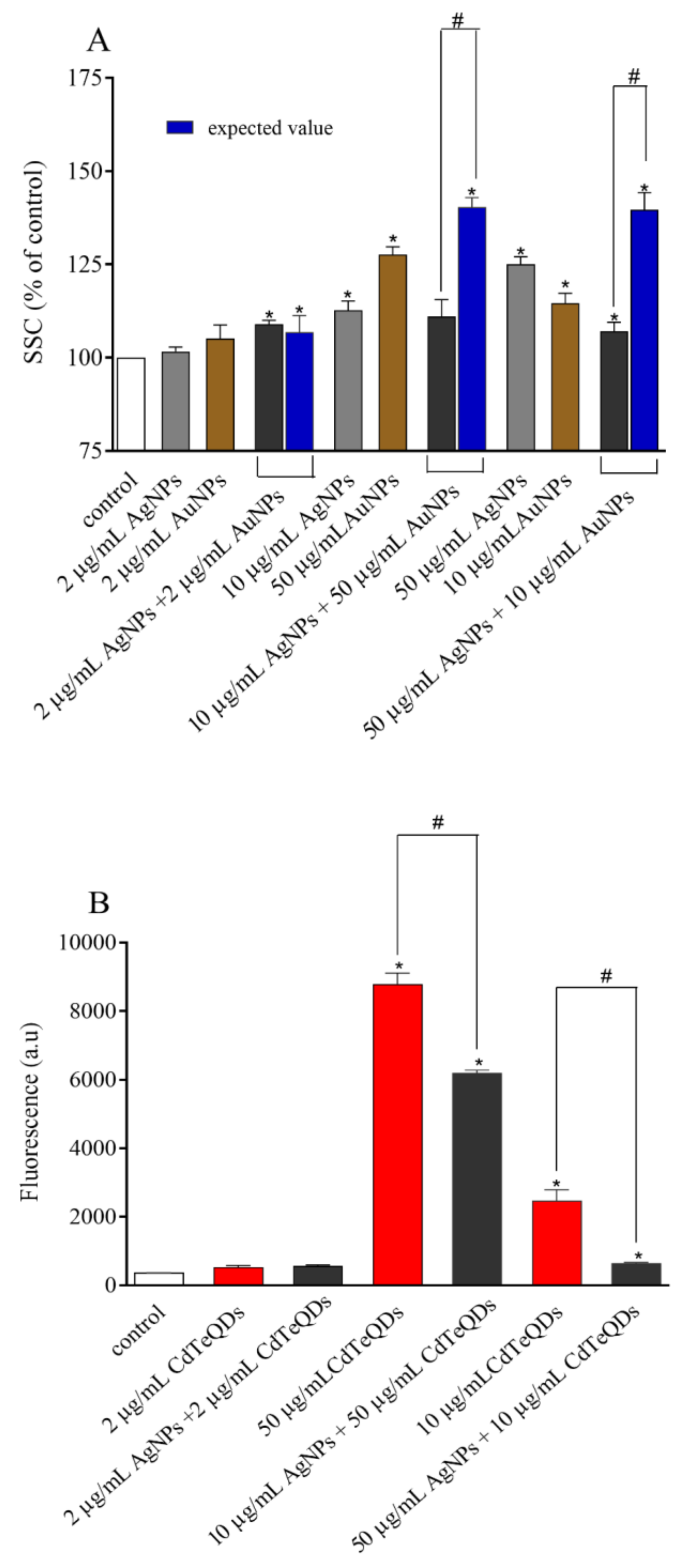
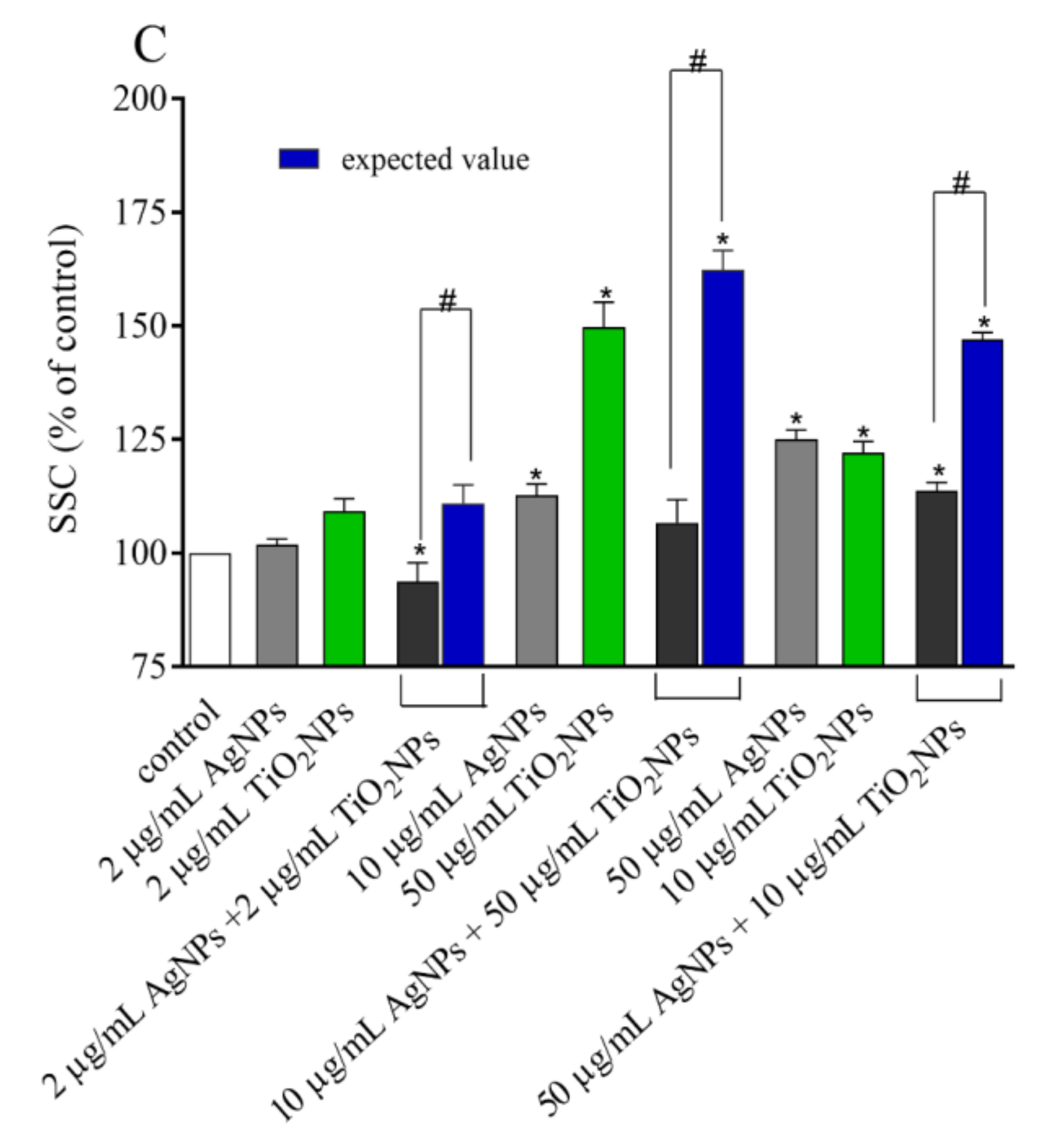
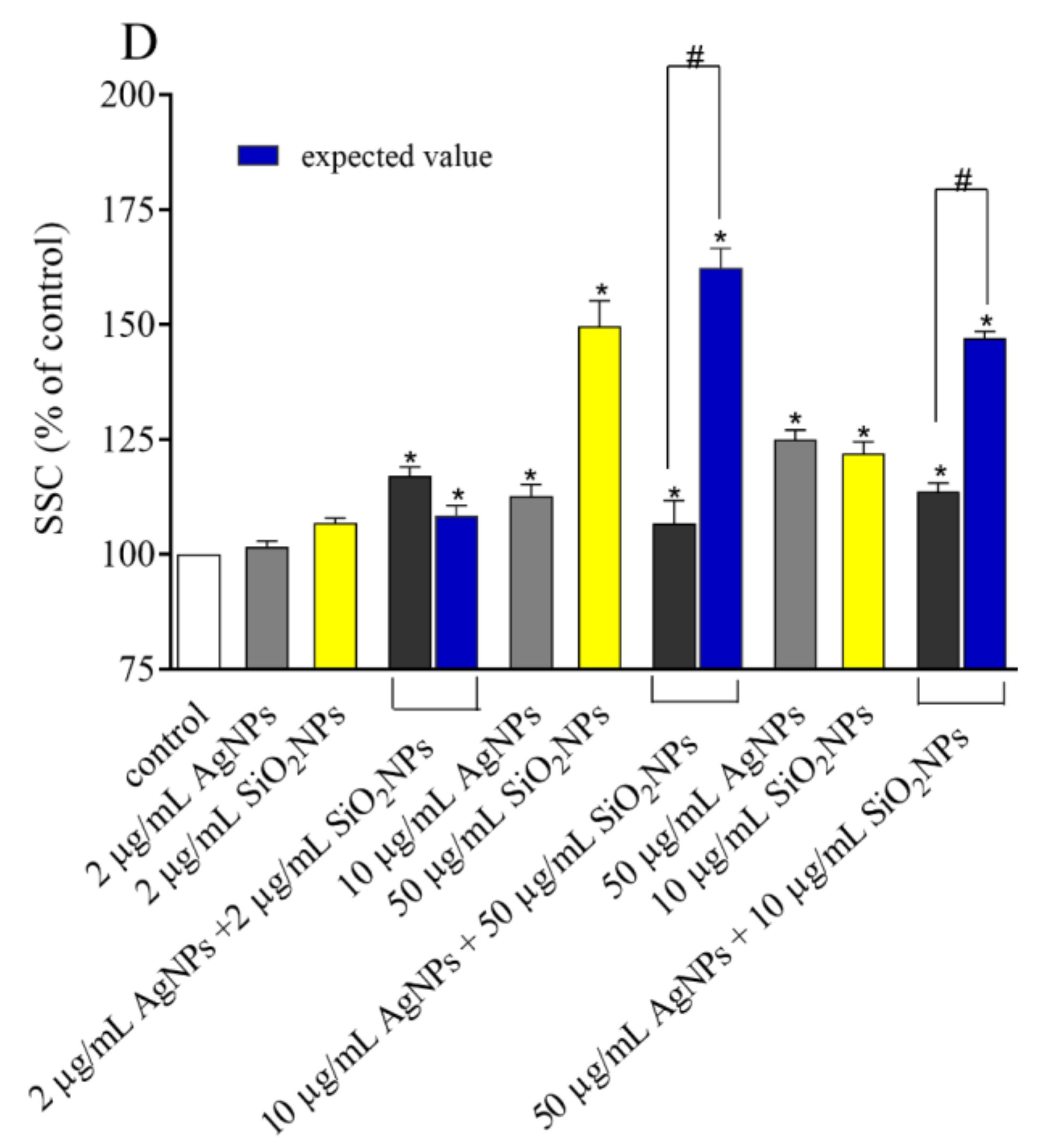

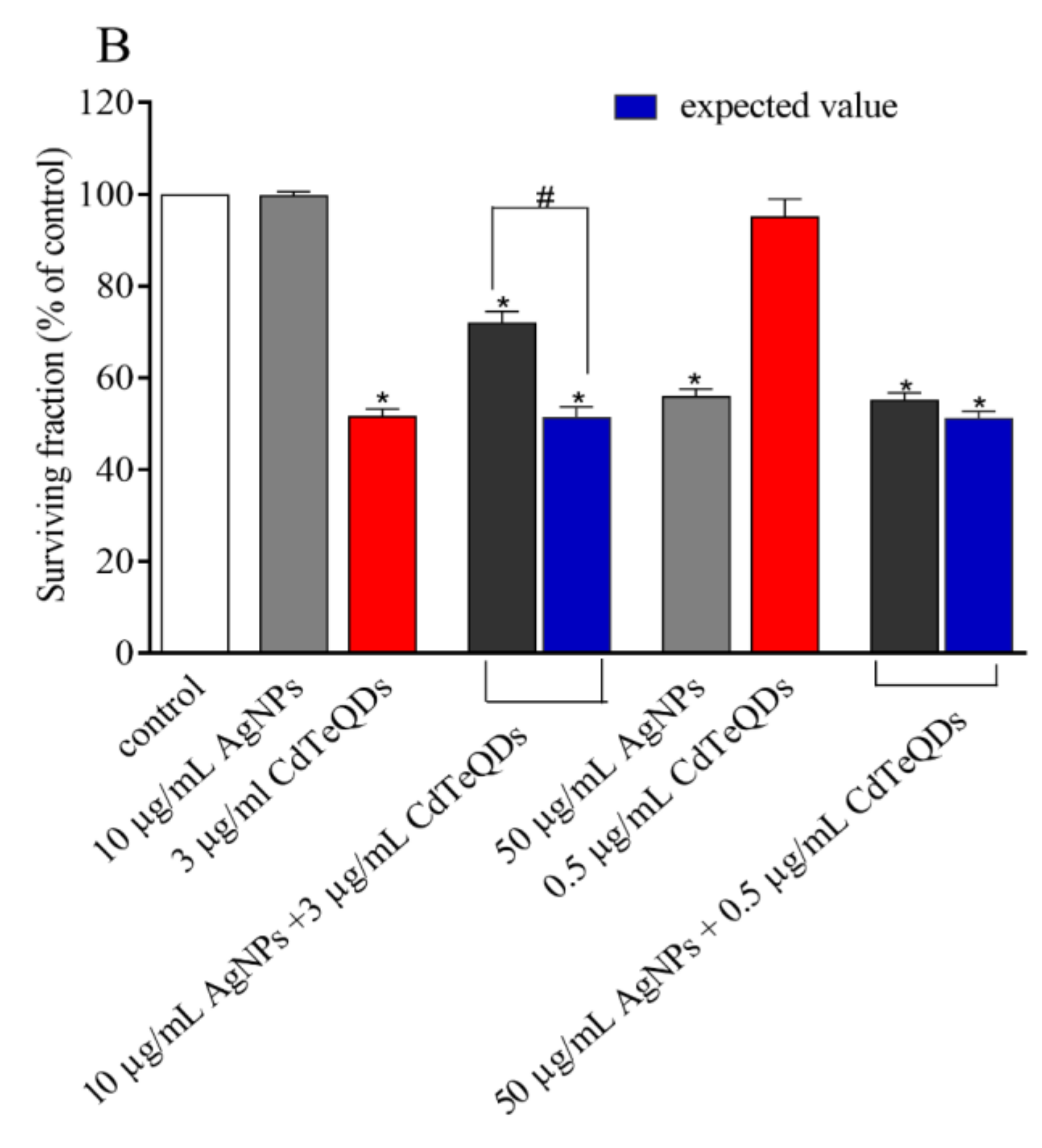
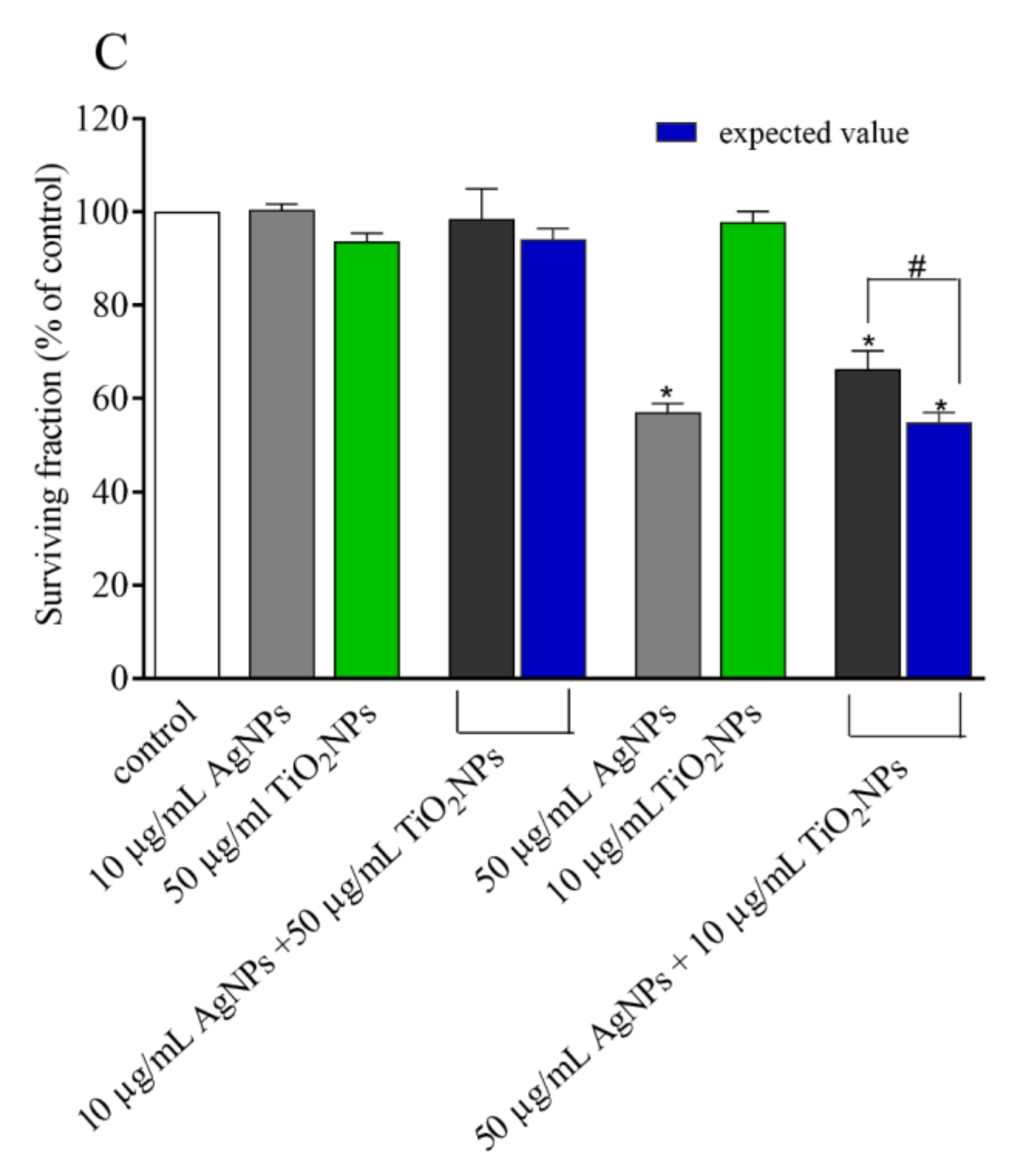
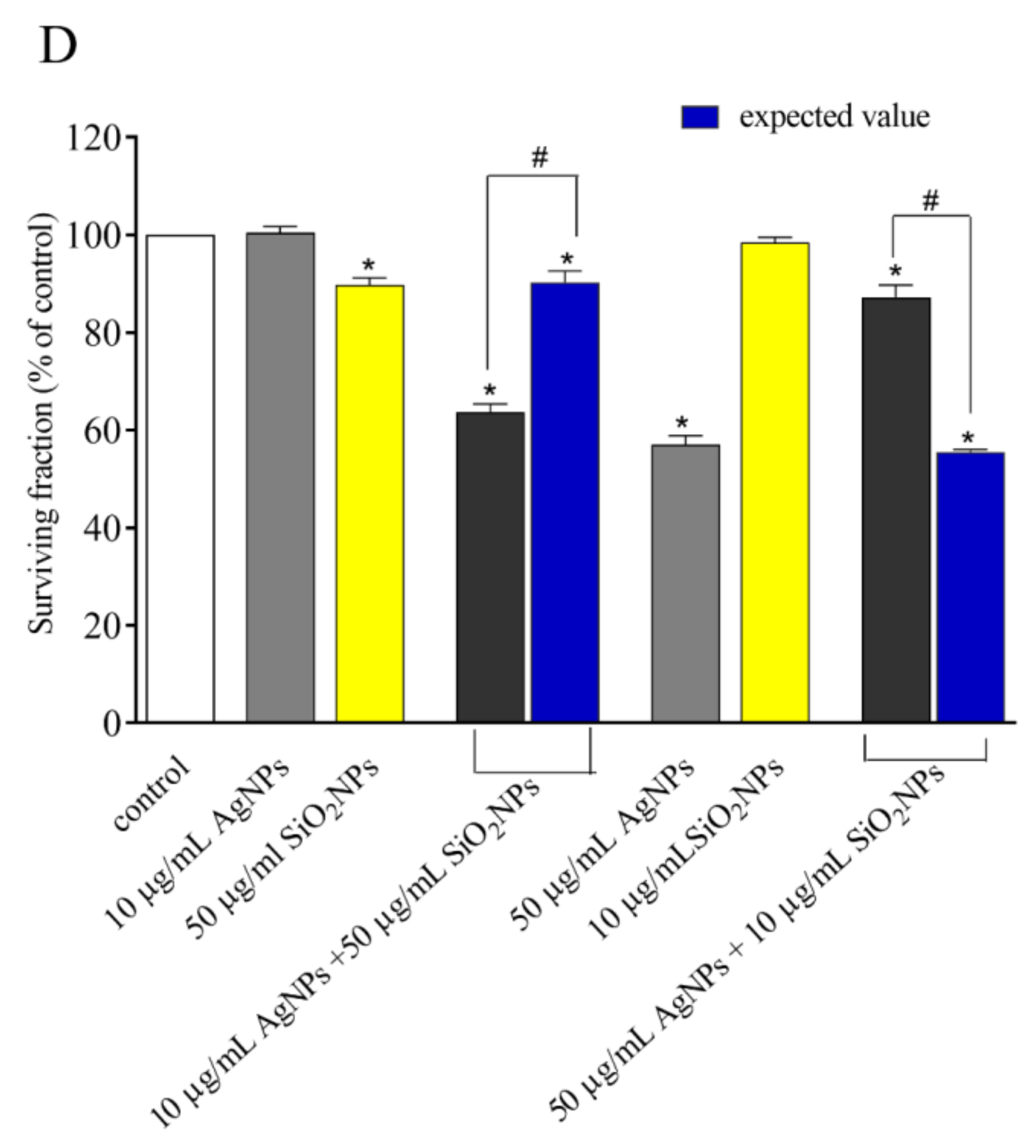
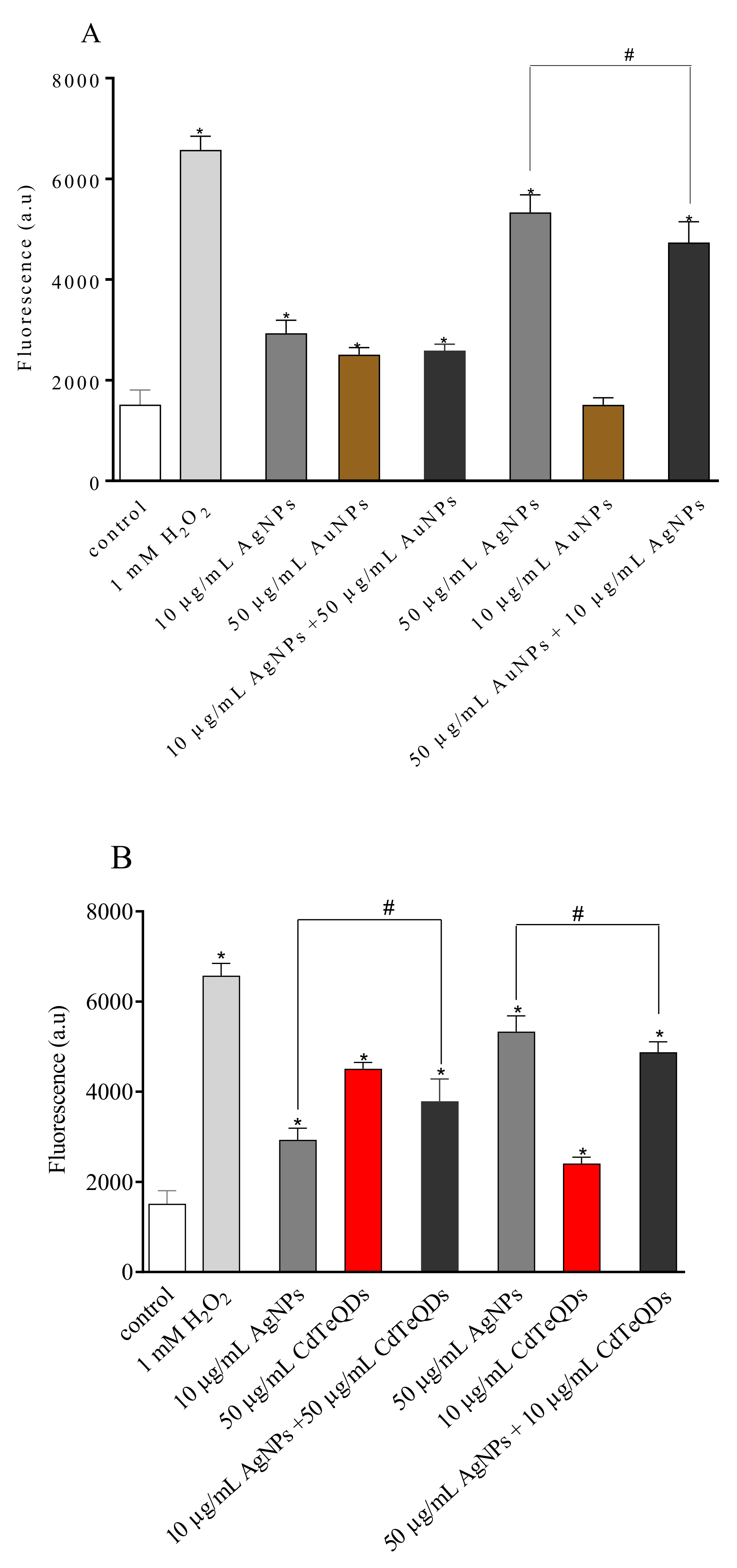
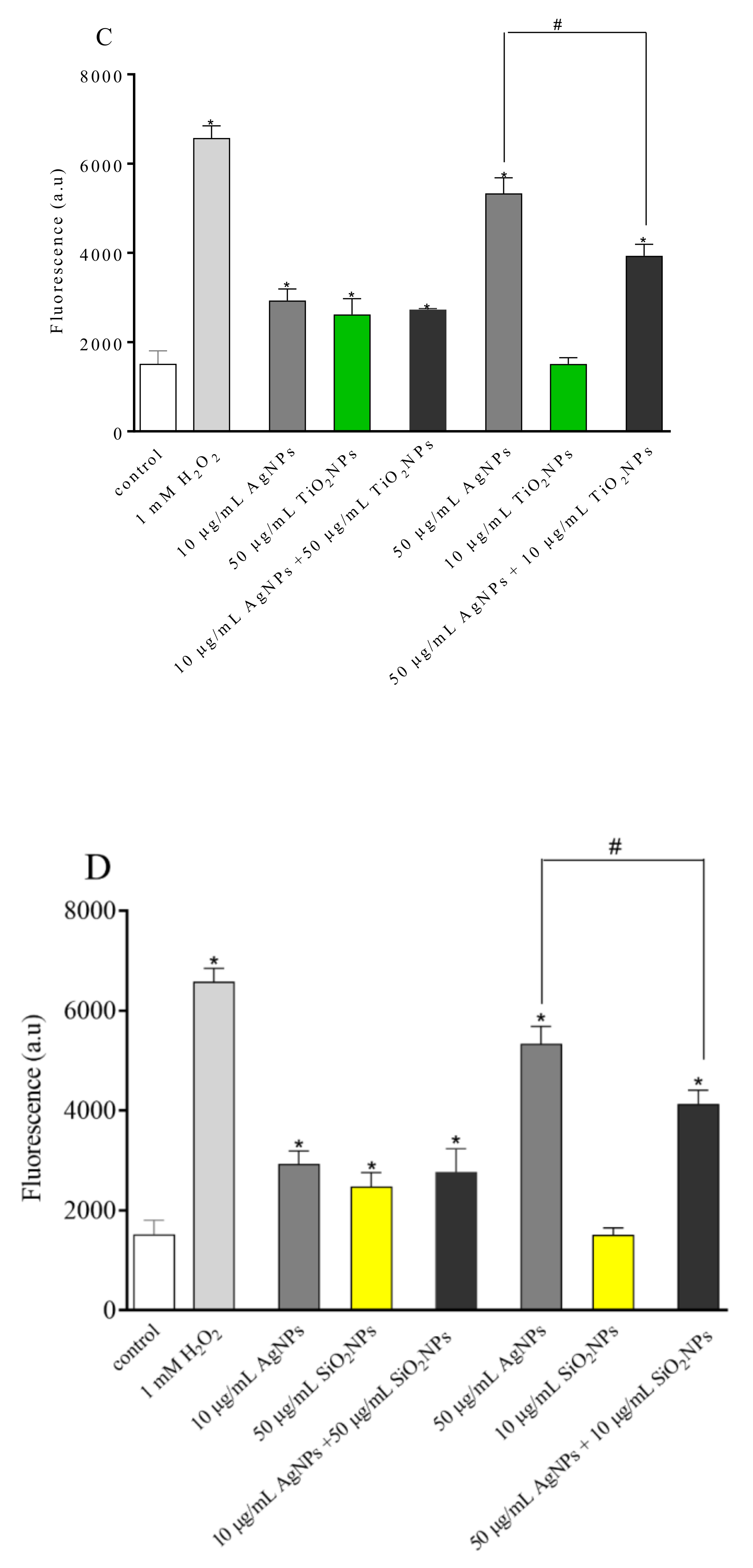

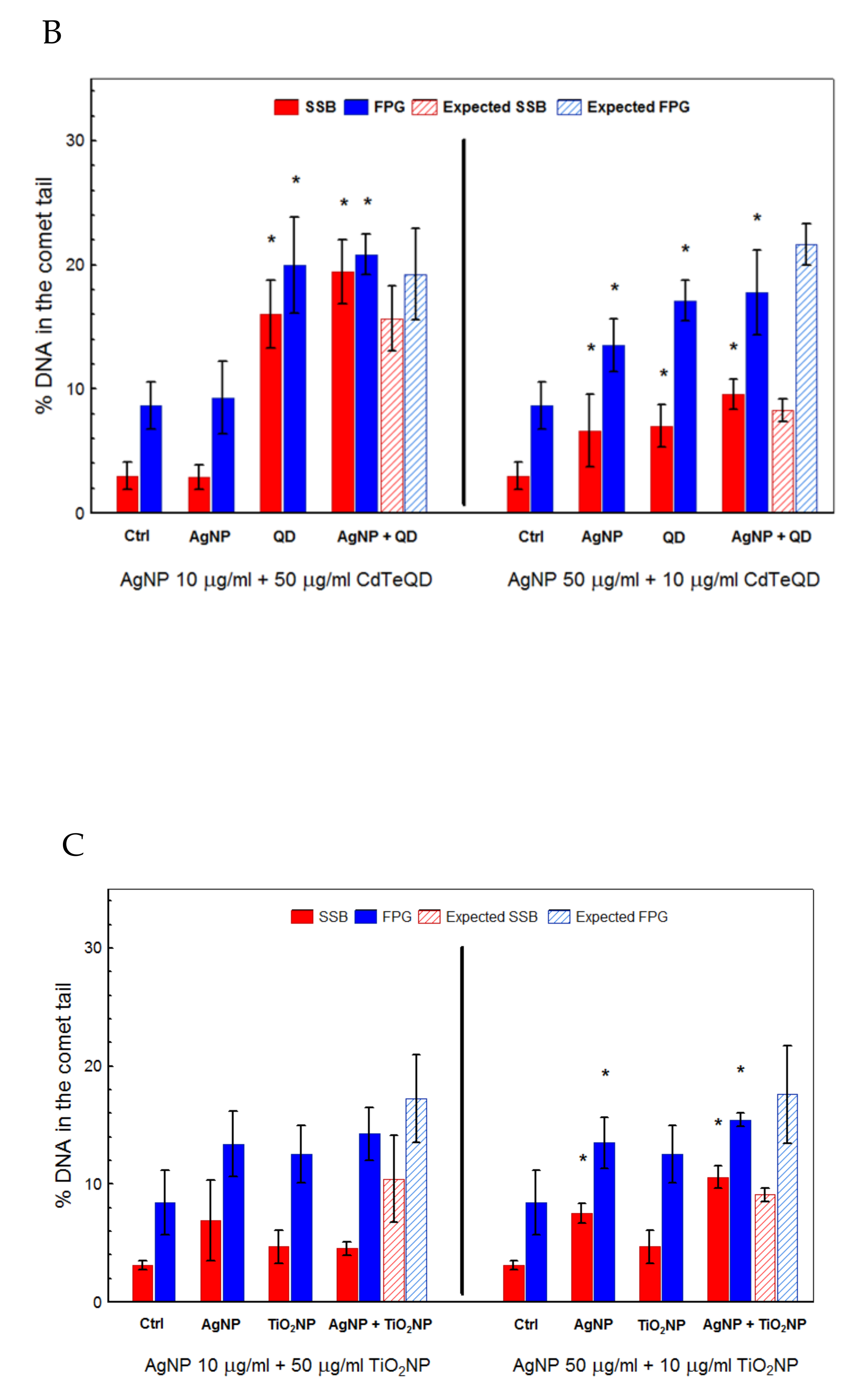

| Nanoparticle/ Nanoparticle Mixture | Hydrodynamic Diameter | PDI | Zeta Potential |
|---|---|---|---|
| AgNPs | 86 ± 2 | 0.317 ± 0.04 | –28.3 ± 0.5 |
| AuNPs | 25 ± 1 | 0.135 ± 0.02 | –45.6 ± 0.5 |
| AgNPs:AuNPs | 95 ± 3 | 0.420 ± 0.05 | –35.7 ± 2.5 |
| CdTeQDs | 96 ± 2 | 0.480 ± 0.07 | –10.5 ± 0.2 |
| AgNPs: CdTeQDs | 158 ± 2 | 0.535 ± 0.05 | –45.6 ± 1.1 |
| TiO2NPs | 246 ± 1 | 0.193 ± 0.07 | –25.5 ± 0.6 |
| AgNPs: TiO2NPs | 446 ± 6 | 0.598 ± 0.10 | –37.2 ± 2.6 |
| SiO2NPs | 124 ± 6 | 0.380 ± 0.02 | –20.2 ± 2.0 |
| AgNPs: SiO2NPs | 187 ± 33 | 0.452 ± 0.02 | –25.8 ± 4.8 |
| NPs | Time | Hydrodynamic Diameter (nm) | PDI |
|---|---|---|---|
| Ag | 0 min | 86 ± 2 | 0.317 ± 0.04 |
| 15 min | 98 ± 5 | 0.288 ± 0.07 | |
| 30 min | 153 ± 4 | 0.262 ± 0.10 | |
| 60 min | 158 ± 2 | 0.276 ± 0.02 | |
| 120 min | 151 ± 5 | 0.279 ± 0.08 | |
| Au | 0 min | 25 ± 1 | 0.135 ± 0.02 |
| 15 min | 28 ± 2 | 0.145 ± 0.07 | |
| 30 min | 29 ± 2 | 0.137 ± 0.05 | |
| 60 min | 26 ± 2 | 0.130 ± 0.01 | |
| 120 min | 28 ± 3 | 0.141 ± 0.05 | |
| CdTeQDs | 0 min | 96 ± 2 | 0.480 ± 0.07 |
| 15 min | 149 ± 8 | 0.450 ± 0.05 | |
| 30 min | 148 ± 10 | 0.505 ± 0.07 | |
| 60 min | 150 ± 6 | 0.489 ± 0.12 | |
| 120 min | 159 ± 3 | 0.493 ± 0.07 | |
| TiO2 | 0 min | 246 ± 1 | 0.193 ± 0.07 |
| 15 min | 242 ± 5 | 0.203 ± 0.04 | |
| 30 min | 250 ± 3 | 0.196 ± 0.01 | |
| 60 min | 244 ± 3 | 0.194 ± 0.23 | |
| 120 min | 241 ± 1 | 0.173 ± 0.08 | |
| SiO2 | 0 min | 124 ± 6 | 0.380 ± 0.02 |
| 15 min | 133 ± 7 | 0.340 ± 0.06 | |
| 30 min | 127 ± 4 | 0.300 ± 0.12 | |
| 60 min | 140 ± 4 | 0.360 ± 0.09 | |
| 120 min | 139 ± 1 | 0.290 ± 0.04 |
| NPs Mixture* | Time | Hydrodynamic Diameter (nm) | PDI |
|---|---|---|---|
| Ag:Au | 0 min | 95 ± 3 | 0.420 ± 0.05 |
| 5 min | 106 ± 5 | 0.320 ± 0.03 | |
| 30 min | 129 ± 8 | 0.410 ± 0.05 | |
| 60 min | 126 ± 8 | 0.420 ± 0.01 | |
| 120 min | 117 ± 8 | 0.410 ± 0.5 | |
| Ag:CdTeQDs | 0 min | 158 ± 6 | 0.535 ± 0.05 |
| 15 min | 167 ± 8 | 0.550 ± 0.05 | |
| 30 min | 189 ± 6 | 0.535 ± 0.05 | |
| 60 min | 158 ± 8 | 0.589 ± 0.02 | |
| 120 min | 172 ± 6 | 0.593 ± 0.07 | |
| Ag:TiO2 | 0 min | 446 ± 6 | 0.598 ± 0.10 |
| 15 min | 450 ± 9 | 0.670 ± 0.05 | |
| 30 min | 636 ± 10 | 0.660 ± 0.02 | |
| 60 min | 685 ± 6 | 0.610 ± 0.06 | |
| 120 min | 625 ± 7 | 0.730 ± 0.01 | |
| Ag:SiO2 | 0 min | 187 ± 3 | 0.452 ± 0.02 |
| 15 min | 191 ± 2 | 0.430 ± 0.01 | |
| 30 min | 211 ± 9 | 0.470 ± 0.01 | |
| 60 min | 246 ± 3 | 0.465 ± 0.01 | |
| 120 min | 253 ± 5 | 0.468 ± 0.03 |
© 2020 by the authors. Licensee MDPI, Basel, Switzerland. This article is an open access article distributed under the terms and conditions of the Creative Commons Attribution (CC BY) license (http://creativecommons.org/licenses/by/4.0/).
Share and Cite
Męczyńska-Wielgosz, S.; Wojewódzka, M.; Matysiak-Kucharek, M.; Czajka, M.; Jodłowska-Jędrych, B.; Kruszewski, M.; Kapka-Skrzypczak, L. Susceptibility of HepG2 Cells to Silver Nanoparticles in Combination with other Metal/Metal Oxide Nanoparticles. Materials 2020, 13, 2221. https://doi.org/10.3390/ma13102221
Męczyńska-Wielgosz S, Wojewódzka M, Matysiak-Kucharek M, Czajka M, Jodłowska-Jędrych B, Kruszewski M, Kapka-Skrzypczak L. Susceptibility of HepG2 Cells to Silver Nanoparticles in Combination with other Metal/Metal Oxide Nanoparticles. Materials. 2020; 13(10):2221. https://doi.org/10.3390/ma13102221
Chicago/Turabian StyleMęczyńska-Wielgosz, Sylwia, Maria Wojewódzka, Magdalena Matysiak-Kucharek, Magdalena Czajka, Barbara Jodłowska-Jędrych, Marcin Kruszewski, and Lucyna Kapka-Skrzypczak. 2020. "Susceptibility of HepG2 Cells to Silver Nanoparticles in Combination with other Metal/Metal Oxide Nanoparticles" Materials 13, no. 10: 2221. https://doi.org/10.3390/ma13102221
APA StyleMęczyńska-Wielgosz, S., Wojewódzka, M., Matysiak-Kucharek, M., Czajka, M., Jodłowska-Jędrych, B., Kruszewski, M., & Kapka-Skrzypczak, L. (2020). Susceptibility of HepG2 Cells to Silver Nanoparticles in Combination with other Metal/Metal Oxide Nanoparticles. Materials, 13(10), 2221. https://doi.org/10.3390/ma13102221








